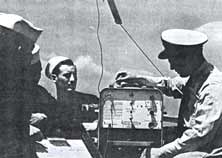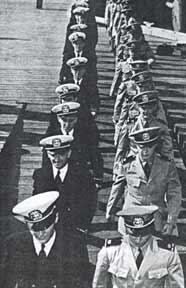United States Maritime Service Radio Training Station in Boston Harbor
Gallups Island school produces "well grounded" men for vital radio jobs in our Victory FleetTo a stranger, Gallups Island, site of the United States Maritime Service Radio Training Station, is not unlike an isolated, yet pleasant, mountain lake resort. Seven miles from shore and just one of the many islets that dot Boston's line harbor, Gallups breathes informality but it is not long before one recognizes the effortless, yet unmistakable, poise of quiet efficiency underneath its peaceful exterior. It is an efficiency that has transformed 2,830 men from all walks of life into expertly-trained Merchant Marine radio operators since Pearl Harbor.
Seven Miles out in Boston Harbor, Gallups Island enjoys pleasant isolation.
At dock is "Calvert," the Shuttle BoatThese men, trained in a specialty which demands the highest type of man in the U.S. Maritime Service, are now manning the radio rooms of innumerable merchant ships carrying the necessities of war to our battle fronts. And every week some 50 more are being graduated with the rank of warrant officer to help fill the requirements which eventually will demand three radio operators aboard every merchant ship so that a 24-hour vigil may be kept.
Outdoor indoctrination class. Officer gives talk on
rules and regulations to incoming traineesAs it has been with other Merchant Seamen, many Gallups Island men have given their lives in helping to deliver the goods to the men who deliver the punch. Perhaps the most fitting tribute to the men from this station is one which is also applicable to all Merchant Seamen who have faced disaster and lost.
This tribute is inscribed on a monument recently erected on Gallups Island and is dedicated to the memory of those men who have made the supreme sacrifice. The engraved wording a constant reminder and inspiration to men now in training --- reads: "BY THEIR DEEDS MEASURE YOURS."
Gallups Island and the Maritime Service are proud of the men they have trained. Like the thousands of other men trained by the Service under the terrible urgency of war, they are doing their jobs and are doing them well on widely-scattered ships that dot the seven seas. These men of Gallups Island represent something new in the history of the American Merchant Marine. They are a part --- a numerically small but highly-specialized part --- of a planned, large-scale, intensive program involving the application of the best modern techniques of testing and classification to men of proven aptitude and then giving these men the knowledge and skills, through intelligent training, to fit them for their highly important jobs at sea.
Thus it is that the finely balanced training period of from 20 to 32 weeks (20 weeks now) makes easy the transition from dryland sailor to sea-going man. A Gallups Island man makes this adjustment quickly. He possesses "savvy." He needs only a pair of sea legs and a few watches on board to justify the time and money that have been spent in training him.
Aboard ship, the licensed radio operator is a department in himself, responsible only to the master of the vessel. He has freedom of action and decision in the event of emergency when he is more than likely to display that skill and "savvy' he has acquired at Gallups Island.
Originally an apprentice seaman at an U.S. Maritime Service Training Station could be enrolled at Gallups Island Radio Training Station merely by requesting it. Now, however, trainees are chosen after careful thought and consideration by classification officers. How well this system of selection has succeeded may be measured by comparing the terrific attrition rate before the program went into effect with the very few who "wash out" under the new method. Experience also has proved that only those men who receive scores well above average in most of the standard psychological tests and possess good educational background, plus positive code aptitude, can hope to survive the heavy, concentrated doses of code, theory and laboratory work which they must digest to be graduated from Gallups Island.
To present a picture of the average student at Gallups Island, it appears he is the survivor of a rigorous process of screening and elimination --- a process which virtually guarantees his competence. According to tests he is mentally capable of absorbing a concentrated course of training in a short period of time. He is about 22 years of age and has had one to two years of college, regards himself as a career man and is definitely dedicated to the idea of remaining in the Merchant Marine in the post-war period.
Gallups Island has been forced, by the demands of war, to accelerate its program many times. From a station of a few buildings housing a couple of hundred men and producing some 22-30 graduates every six weeks, Gallups has been geared to turn out 50 men a week while clothing, feeding, housing and providing medical and recreational facilities for a total trainee and administrative complement of some 1200 men. As the station grew, instruction techniques were stepped up, non-essentials curtailed and new, improved methods adopted. It might be safe to say, perhaps, that from the moment a trainee enters Gallups Island there is hardly a waste motion made or breath taken, so well-oiled and efficient is the training program.



 The training department is divided
into three distinct divisions, each necessary hut not sufficient in itself
for giving the radio trainee the proper equipment to go to sea as a licensed
operator. Together, the three divisions --- Operations, Radio Engineering
and Laboratory --- contribute everything toward the manufacture of a well-rounded
and thoroughly grounded 'Sparks.'
The training department is divided
into three distinct divisions, each necessary hut not sufficient in itself
for giving the radio trainee the proper equipment to go to sea as a licensed
operator. Together, the three divisions --- Operations, Radio Engineering
and Laboratory --- contribute everything toward the manufacture of a well-rounded
and thoroughly grounded 'Sparks.'




 The Normandy invasion has
emphasized the need for more ships and more men to man the ships. New
blows by the Allied forces certainly are being conceived and still more
merchant ships and more radio operators will be required. The newly-established
policy that all American merchant ships carrying the necessities of war
to all the global fronts carry three Merchant Marine radio operators
has forced upon the Maritime Service the immediate necessity of
turning out more men to handle the radio watch aboard ship than the maximum
capacity of Gallups Island can accommodate.
The Normandy invasion has
emphasized the need for more ships and more men to man the ships. New
blows by the Allied forces certainly are being conceived and still more
merchant ships and more radio operators will be required. The newly-established
policy that all American merchant ships carrying the necessities of war
to all the global fronts carry three Merchant Marine radio operators
has forced upon the Maritime Service the immediate necessity of
turning out more men to handle the radio watch aboard ship than the maximum
capacity of Gallups Island can accommodate.